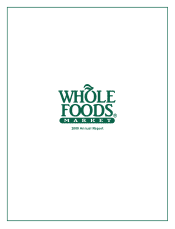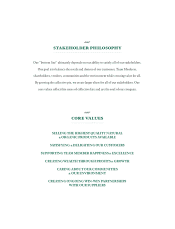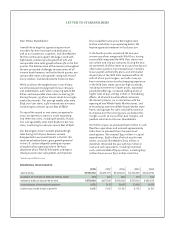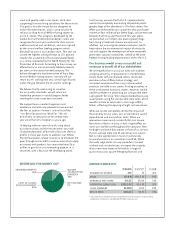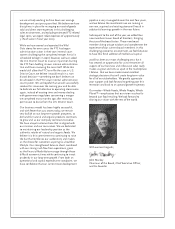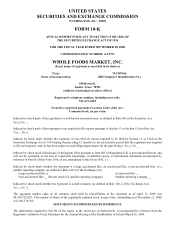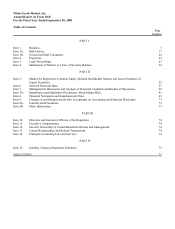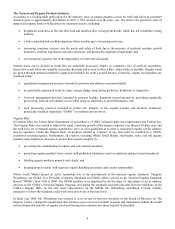Whole Foods 2008 Annual Report Download - page 5
Download and view the complete annual report
Please find page 5 of the 2008 Whole Foods annual report below. You can navigate through the pages in the report by either clicking on the pages listed below, or by using the keyword search tool below to find specific information within the annual report.
meat and poultry sold in our stores, while also
supporting humane living conditions for the animals.
Our goal is to make it easy for our shoppers to
make informed choices, and in 2009 we plan to
roll out a 5-Step Animal Welfare Rating system to
our U.S. stores. This program, developed by the
Global Animal Partnership foundation, ranks and
recognizes farmers and ranchers for their animal
welfare practices and conditions, and was inspired
by the animal welfare labeling program which
debuted last year in our London store. This year we
scored the highest among the top 25 U.S. grocery
retailers for availability of humanely labeled foods
in a survey conducted by the World Society for the
Protection of Animals. According to their survey, we
offered twice as many humanely-labeled products
per store as the second-ranked company. We
believe through the implementation of the 5-Step
Animal Welfare Rating system, not only will we
retain our #1 ranking next year, we will significantly
widen the gap between the #1 and #2 rankings.
We believe that by continuing to raise the
bar on quality standards, we will retain our
leadership position in natural/organic foods
retailing for many, many years to come.
We support team member happiness and
excellence and were very pleased to have earned
the No. 22 spot on Fortune’s annual list of the
“100 Best Companies to Work For.” We are
one of only 13 companies to be ranked every
year since the list’s inception 12 years ago.
In keeping with our core value of caring about
our communities and the environment, we made
charitable donations of over 5% of our net after-tax
profits in fiscal year 2008. In addition, our Whole
Planet Foundation, whose mission is to empower the
poor through microcredit in communities that supply
our stores with product, has committed over $7.9
million in grants to 12 microlending projects in 11
countries, with a focus on the developing world.
Last January, we were the first U.S. supermarket to
commit to completely eliminating disposable plastic
grocery bags at the checkouts in all of our stores. Our
effort was embraced by our customers who purchased
between Earth Day and the end of this year alone,
we prevented 100 million new plastic grocery bags
from being introduced into our environment. In
addition, our annual green power purchases, which
help reduce the environmental impact of electricity
use and support the development of new renewable
generation capacity nationwide, ranked as the sixth
highest among leading organizations within the U.S.
Our business model is very successful and
continues to benefit all of our stakeholders.
We are hopeful that in 2009 our sales will stabilize
and grow driven by improvements in the Wild Oats
stores, fewer self-cannibalized stores, continued
execution of our differentiation strategy, and
increased awareness of the many value-oriented
products available in our stores. Finding ourselves in
these unchartered economic waters, however, we did
not feel confident in predicting our comparable store
sales growth for 2009. We instead provided base-case
assumptions using flat comparable store sales, which
would translate to total sales in the range of $8.3
billion, reflecting the opening of eight net new stores.
While we cannot completely control the impact of
the economy on our sales, we can control our capital
expenditures and many of our costs. When we
opened our enormously successful 80,000 square
foot store in Austin in 2005, it had a ripple effect on
store size and format throughout the company. With
hindsight and some data points in front of us, we see
that an average store size of around 40,000 square
feet is more appropriate in most circumstances
to maximize return on investment and EVA. While
the really large stores are very powerful in limited
markets and circumstances, we expect the majority
of our new store leases to fall within a range of
35,000 to 50,000 square feet going forward, and
GROWTH SINCE IPO
9/28/08 9/29/91* CAGR
NUMBER OF STORES 275 10 21%
SALES $8.0 B $92.5 M 30%
EARNINGS PER SHARE $0.82 $0.08 14%
OPERATING CASH FLOW $325.8 M $3.4 M 31%
TEAM MEMBERS 52,900 1,100 25%
STOCK PRICE $20.64 $2.13 15%
* 1991 results do not include the impact of subsequent pooling transactions and accounting
restatements. Stock price is split-adjusted IPO price in January 1992.
INCOME
TAXES/OTHER
EXPENSES
10%
NET INCOME
1%
25%
SALARIES/BENEFITS
COST OF GOODS
SOLD/OCCUPANCY
64%
WHERE DID THE MONEY GO?
more than four million of our Better Bags, and we estimate

